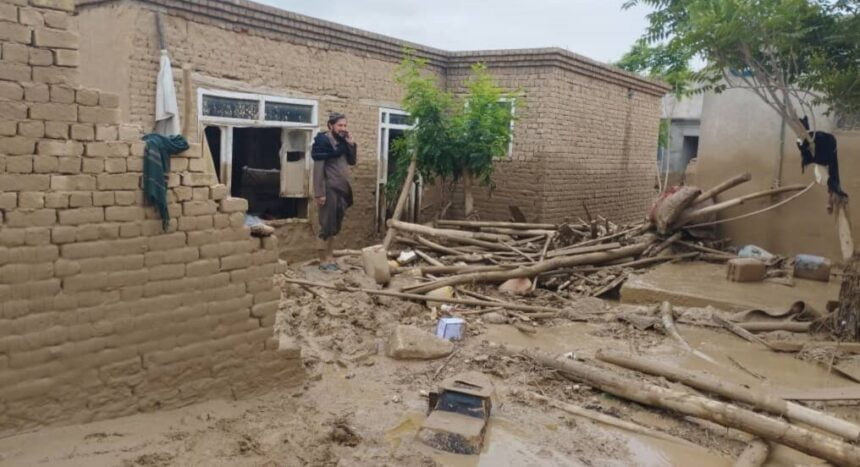Heavy rains and floods have wreaked havoc across Afghanistan, with the northern provinces of Baghlan, Takhar, Badakhshan and the western provinces of Herat and Ghor bearing the brunt of the disaster. The death toll has surpassed 350, with over 2,000 injured and hundreds more missing, according to officials from the Taliban government and aid agencies.
According to the Ministry of Refugees and Repatriation of the Taliban government, the recent floods in Baghlan province have caused 315 fatalities and 1,630 injuries. In a press release from May 12th, based on data from its office in Baghlan, the ministry reported that these floods also ruined 2,665 houses and killed thousands of livestock.
Earlier, the World Food Programme (WFP) reported a higher death toll in Baghlan, exceeding 310 fatalities. In the last 48 hours, the floods in Takhar, Badakhshan, Samangan, Ghor, Herat, and a few other provinces have also killed dozens of people and caused widespread destruction, with thousands of homes completely or partially destroyed.
The situation in the affected areas remains fluid, with casualty figures constantly changing as rescue and recovery efforts continue.
Baghlan: A Region in Crisis
A fifty-year-old resident of Central Baghlan, Ashraf Khan, described the situation to Afghan Insight as “apocalyptic,” stating that “the flood killed seven members of his family, including three children and two women.”
Rasool Khan Baghlani, a local leader in Baghlan, told Afghan Insight, “We are unsure of the exact number of casualties, but I have been informed of over three hundred deaths or disappearances in the past forty-eight hours alone.” He added that locals are busy burying the dead, treating the injured, and providing temporary shelters for the displaced under challenging conditions, making it difficult to ascertain the exact numbers of dead, injured, or missing. According to Baghlani, many bodies are still believed to be under the rubble in areas severely affected by the floods, and it might take several days to fully understand the extent of the incident and the losses incurred.
In the district of Burka in Baghlan province alone, the Taliban government’s security commander, Mullah Jan Mohammad Hamza, reported over “200” deaths due to the floods. He noted that many buried individuals have been retrieved, and efforts to find others continue.
Takhar and Other Provinces Also Suffered
Officials from the Department of Natural Disasters in Takhar reported that the recent floods have killed more than twenty people, destroyed hundreds of residential homes, and devastated hundreds of agricultural lands, causing significant financial and human losses to the local population. Chal, Ashkamish, Namak Ab, and Farkhar districts have been particularly hard-hit, raising concerns about more casualties and damage.
Reports from Samangan province highlight the loss of life and extensive damage to agricultural land caused by the floods.
Several other provinces, such as Ghor, Badakhshan, and Herat, also suffered many deaths and damage from intense floods across these areas in the past two days.
Videos circulating on social media depict powerful floodwaters surging through villages and farms, underscoring the magnitude of the disaster.
Government and International Response
Taliban government spokesman Zabihullah Mujahid stated that the ministries of Disaster Management, Defense, and Interior, along with local authorities, have been instructed to assist the flood-affected and to utilize all available resources.
Earlier, Mullah Janan Sayeq, spokesperson for the Ministry of State for Disaster Management, said that aid groups had reached the flood-affected areas and provided shelter and food to the residents.
Previously, heavy rains in western Afghanistan had resulted in floods that killed dozens and required thousands of other humanitarian aid. Last month’s floods damaged nearly 2,000 homes, three mosques, and four schools.
The United Nations has announced its coordination with the Taliban government to deliver emergency aid to the victims. UN Secretary-General Antonio Guterres expressed his deep concern over the casualties and pledged support for relief efforts.
Meteorological Forecasts and Warnings
The Ministry of Transport and Civil Aviation’s Meteorological Department has issued warnings of potential further adverse weather conditions across multiple provinces, including Badakhshan, Baghlan, Panjshir, Laghman, Kunar, Nuristan, and Nangarhar. This forecast necessitates continued vigilance and preparedness against potential new flooding events.
Afghanistan’s Vulnerability to Climate Change
Afghanistan is one of the countries most vulnerable to climate change and least prepared to cope with its effects. The recent floods and the severe drought the country experienced just a few months ago highlight the increasing frequency and intensity of extreme weather events in Afghanistan.
Experts attribute these devastating natural disasters to climate change, which has disrupted rainfall patterns and caused drought.





